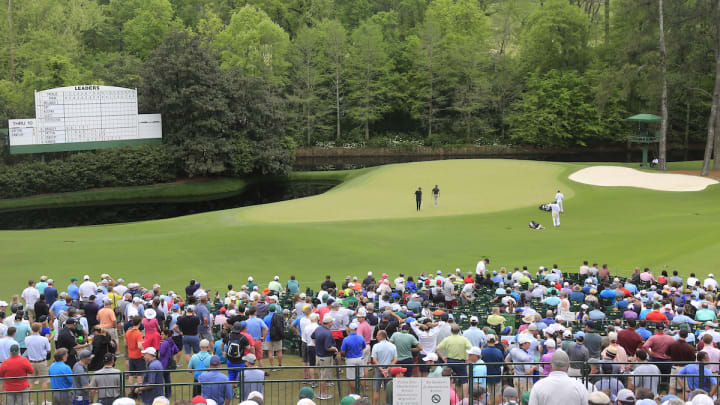Masters 11th Hole: Stats, History, Memorable Moments From Augusta National’s Par-4 ‘White Dogwood’

A closer look at Augusta National Golf Club's 11th hole for this year's Masters:
Name: White Dogwood
Par: 4
2022 yardage: 520
1934 yardage: 415
2021 scoring average: 4.40
All-time scoring average: 4.30
All-time difficulty rank: 2
Lowest year: 4.06 [1995]
Highest year: 4.64 [1956]
THE LAYOUT
The hole began with a ho-hum design — downhill, 415 yards and with an ever-so-slight dogleg to the right. Through the years, White Dogwood has become quite formidable. Today, golfers must hit a tee shot from a visually tight chute of pine trees, and the downhill approach grows in complexity due to the unpredictable winds that whip up and the greenside pond that was introduced in 1950.
SIGNIFICANT CHANGES
1950: Masters tees relocated. Pond left of green built. Green reshaped.
1953: Two small bunkers added at rear of green.
1990: Green rebuilt due to flood damage.
1999: Green, pond and bunker complex adjusted.
2002: Masters tees moved back 30-35 yards and moved five yards to golfer’s right. Portion of fairway landing area regraded.
2004: Pine trees (36) added to the right of the fairway.
2006: Masters tees moved back 10-15 yards. Trees added to the right side of the fairway, and fairway shifted to the left.
2008: Several trees removed on right side of fairway, and fairway widened.
2022: Masters tees have been moved back 15 yards and to the golfers' left. The fairway has been recontoured and trees have been removed on the right side.
Notes: This is the first of five back-nine holes in which water comes into play. … In the early years, Rae’s Creek ran partially along the green’s left side. Following the 1950 Masters, the creek was dammed to create the pond that exists today. So intimidating is the pond’s presence that Ben Hogan quipped in 1951: “If you ever see me on the 11th green in two, you’ll know I missed my second shot.”
ODDS AND ENDS
The 11th marks the beginning of Amen Corner, which was a term Herbert Warren Wind wrote in a Masters recount for Sports Illustrated in 1958. Wind wrote, “at the farthest reach of the Augusta National course – down in the Amen Corner where Rae’s Creek intersects the 13th fairway near the tee, then parallels the front edge of the green on the short 12th and finally swirls alongside the 11th green.” Specifically, the term refers to the approach into the 11th green, all of the par-3 12th and the tee shot at the par-5 13th hole. … Dave Marr, whose best Masters finish was a T-2 in 1964, said of the stretch, “If you get through these holes in even par, you believe a lot more in God.” … Prolific author Dick Schaap’s book, "The Masters: The Winning of a Golf Classic," recounts the 1970 tournament won by Billy Casper in a Monday playoff over fellow San Diegan Gene Littler. The book was significant because it was one of the first of its kind written in timeline form. Here is an excerpt of the Monday playoff: “4:11 p.m.: With a fourteen-foot birdie putt on the eleventh hole, Billy Casper moves back to three-under — and seven strokes in front of Gene Littler. Never in Masters history has there been such a one-sided playoff. Hundreds of spectators drift away from the play. The drama is gone.” … Nick Faldo won successive Masters playoffs (1989 versus Scott Hoch and 1990 versus Raymond Floyd) at the 11th. … In 1954, amateur Billy Joe Patton was playing ahead of Hogan on Sunday. Hogan began the day five strokes ahead of Patton, who, with the aid of an ace at the par-3 sixth, went out in 32 to draw even with Hogan. On the 11th, Hogan heard a roar up ahead at the par-5 13th. Thinking Patton was making birdie, perhaps even eagle, Hogan abandoned his conservative game plan and fired at the pin on the 11th, but found the pond instead. Turns out, Patton was making a 7 at 13 and soon dropped from contention. Hogan would make double bogey at 11, finish tied with Sam Snead through 72 holes and lost the playoff the following day.
MEMORABLE MOMENT
1987: Larry Mize, who was born in Augusta in 1958, helped operate the scoreboard at the third hole as a teenager. At age 28, he found himself in a playoff with Australian Greg Norman, who succumbed to Jack Nicklaus’ back-nine charge a year earlier, and Spaniard Seve Ballesteros, who already had won green jackets in 1980 and 1983. Ballesteros bowed out of the playoff with a bogey at the 10th. At the 11th, Mize was first to hit the approach and attempted to follow a strategy that he used earlier in the final round: hitting safely just off to the right of the green and getting up and down for par. Under a bit more pressure, Mize pushed his playoff approach farther right, leaving himself a tenuous chip of 46 yards to a hole where the green funneled away from him and toward the pond. Norman’s approach found the green’s front-right edge. Mize then did the unthinkable. Using a sand wedge, Mize hit a low shot that skipped twice before reaching the green and then rolled on a direct line into the hole for birdie and one of the Masters’ most memorable victory celebrations.
SEE MORE OF AUGUSTA NATIONAL'S BACK NINE
10 | 11 | 12 | 13 | 14 | 15 | 16 | 17 | 18
